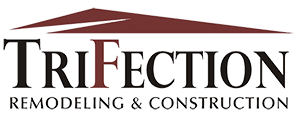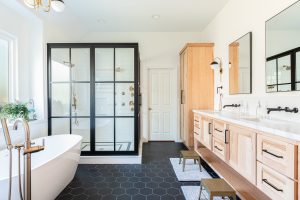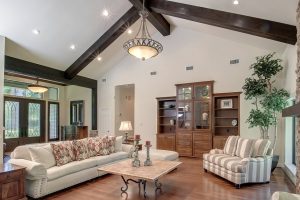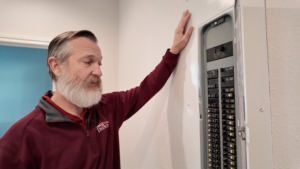 It’s difficult to improve on nature, but that’s exactly what engineered wood floors do. What is engineered wood and how does it compare to hardwood? We’ll explain in this post:
It’s difficult to improve on nature, but that’s exactly what engineered wood floors do. What is engineered wood and how does it compare to hardwood? We’ll explain in this post:
What is Engineered Wood?
The best of them have 3-12 layers, crossed, glued, and pressed together. Inner-core layers are built of either hardwood and/or soft plywood material, incorporating a tongue and groove system. Then, hardwood veneer, made of any one of a variety of wood species, is added as a top wear layer.
Because it resists higher moisture levels, engineered wood floors are ideal for our climate. Quality wood floors can also brings the same resale value as solid wood flooring—if you choose wisely.
Which Engineered Wood Floors Should I Choose?
Ranging in widths from 3” to 7”and thicknesses from 3/8” to 3/4”, engineered wood floors are available in a variety of domestic and exotic hardwood species. You can even get them in popular hand-scraped styles.
 It’s important to check the thickness of the wear layer on the engineered flooring you choose. Those with 0.6mm wear layer can only be re-coated and cannot be sanded and refinished during their 20-30 year lifespan. Engineered wood floors with a wear level of 2-6 mm can be completely sanded and refinished up to five times during their 40-80 years of useful life.
It’s important to check the thickness of the wear layer on the engineered flooring you choose. Those with 0.6mm wear layer can only be re-coated and cannot be sanded and refinished during their 20-30 year lifespan. Engineered wood floors with a wear level of 2-6 mm can be completely sanded and refinished up to five times during their 40-80 years of useful life.
If you prefer a seamlessly smooth appearance, look for Click Loc engineered floors. These floors have a special tongue-and-groove system. Another advantage to this kind of floor is that no glue is needed during installation as they float over a foam or cork underlayment. This is the kind of floor installation often recommended by Home Improvement expert Tom Tynan. Another benefit of these floors is they can be installed over existing floors, as long as they are flat and well-secured.
How Are Engineered Wood Floors Made?
There are two primary methods of creating engineered wood floors. In one, the top wear layer is sliced from the log as with traditional wood flooring, which means they usually have a thicker wear level. These sliced cut floors show a truer, natural look of wood and finer grains.
The other method is rotary cut. In this process, the wear layer’s hardwood veneer is peeled from the log using big lathes. Rotary cut often results in a more dramatic appearance of grain.
Quality Differences in Engineered Floors
While there are cheaper engineered floors that are created to be affordable, a cheap price inevitably becomes a more expensive choice over time. For instance, a paper-thin wear level found on floors, often made overseas in locations such as China, may look good during installation, but often fail over time.  This kind of experience has damaged the perception of engineered wood floors among some consumers. The good news, it’s not necessarily so.
This kind of experience has damaged the perception of engineered wood floors among some consumers. The good news, it’s not necessarily so.
The quality engineered wood floors TriFection recommends are made with better raw materials for clients who demand the best. That’s why we demand this type of wood floors with a wear layer of 4mm (5/32”). Not only can these floors be sanded and refinished up to five times, they last up to 80 years.
Pros of Engineered Floors
Consider how much wood goes into a floor. Fact is, up to four times more engineered flooring can be created with the same materials needed to create a single square foot of 3/4” hardwood flooring. Buying engineered wood flooring isn’t just more affordable, it’s also better for the environment because it helps conserve our forests. Ask a TriFection associate about engineered or hard wood floors for your project.
Contact TriFection Online or Via Phone to Get Started on Your Kitchen or Bathroom Remodel Houston!









